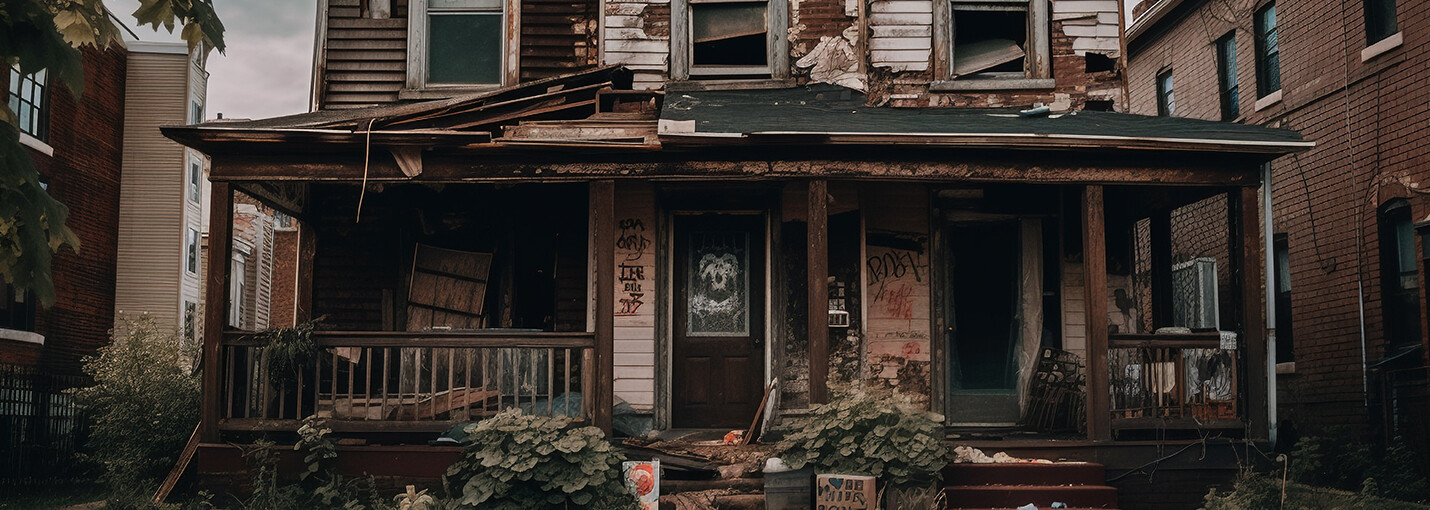Asbestos Siding on Old Houses
In the early 20th century, asbestos emerged as a popular construction go-to due to its remarkable fire resistance, durability, and insulating properties. As a result, the mineral found its way into many building materials, including roofing, insulation, flooring, and siding. Asbestos siding adorned the exterior of countless houses from the 1920s through the 1970s. However, what was once considered a marvel of innovation has become a significant environmental and health concern.
This article will take a look at the risks of asbestos siding and how to properly handle renovation or removal. It’s vital to adhere to strict protocols when working around surfaces containing asbestos. Doing so will prevent serious health and safety issues.
!
If you believe that you were exposed to asbestos, even as a child, speak to a healthcare provider about tests and screening to help diagnose lung-scarring and screen for asbestos-related diseases.
The Presence of Asbestos in Older Homes
As mentioned previously, a home built in the 1920s could contain asbestos. Asbestos was a popular building material throughout most of the 20th century, and it was used in various construction components such as insulation, roofing materials, siding, and flooring. Asbestos insulation and building materials were also used in pipes, electrical wiring insulation, and certain types of textured wall and ceiling coatings. As a result, homes built during this era almost always have some form of asbestos lurking inside.
 |
| Nearly every building constructed before the mid-1980s contained asbestos products and building materials. |
 |
Painting Over Asbestos Siding
If you plan to paint over old asbestos siding, it’s crucial to consider the possible health hazards linked to asbestos. While asbestos is durable, as surfaces begin to corrode over time, its microscopic fibers can become airborne and be easily ingested. Once inside the body, they attach themselves to the lungs and are impossible to remove. This has been linked to serious health issues like lung cancer and mesothelioma with symptoms often developing decades later.
“Generally, those who develop asbestos-related diseases show no signs of illness for a long time after exposure.”Source: National Cancer Institute (NIH)1 |
Siding Glue
Asbestos-containing glue used in siding and in other areas of a home looks like a typical adhesive material, often brownish or grayish. Fibers added to such adhesives enhanced their strength and heat resistance. Of course, it’s important to note that not all glues or other adhesives contain this mineral, but it’s important to be cautious when working with siding in older structures.
Safe Removal of Asbestos Siding
Removing asbestos is dangerous and requires careful planning, specialized equipment, and proper protective measures to ensure the safety of workers and the environment. It is widely understood that exposure to asbestos fibers can pose serious health risks if released into the air and inhaled. Thus, it’s always best to assume asbestos is present in aging buildings, especially if there is corrosion, and to get surfaces tested before moving forward with any renovation work.
“Some asbestos fibers may bypass…your body’s natural defenses…and lodge deep within your lungs. Those fibers can remain in place for a very long time and may never be removed.”Source: American Lung Association |
Getting Surfaces Tested First
The only way to ensure any asbestos siding is identified and handled properly is to get a licensed auditor to sample any areas in question. Specialized labs are equipped to distinguish between asbestos and other additives, and an auditor will use the necessary equipment and protective gear to limit exposure. DIYing asbestos removal is never recommended as this could leave a homeowner open to dire legal, financial, and health consequences.
Asbestos has no taste or smell.
You may not know you’re breathing it.

Licensing in Asbestos Remediation
Safely removing and disposing of asbestos-containing materials from buildings and structures, known as asbestos remediation, is necessary due to the health hazards associated with asbestos exposure. Some of the reasons to work with a licensed contractor include:
Health and Safety: Professionals are trained to use specialized equipment, follow strict protocols, and take necessary precautions to ensure the safety of workers, occupants of the building, and the general public.
Expertise and Training: Licensed remediation professionals undergo rigorous training to understand the properties of asbestos, safe handling procedures, and the use of protective equipment.
Legal Compliance: Many jurisdictions require licensing before carrying out asbestos removal and abatement. Not adhering to these rules may lead to legal consequences. Licensing ensures that the work adheres to local, regional, and sometimes even national, standards.
Proper Disposal: Licensed professionals know the regulations regarding properly disposing of asbestos-containing materials. Improper waste disposal can contaminate the environment, posing potential health hazards to the public.
Risk Mitigation: Asbestos remediation can involve complex procedures, including containment, removal, decontamination, and disposal. Abatement workers are equipped to manage these processes while minimizing risk.
Insurance and Liability: Asbestos remediation contractors often carry liability insurance. This insurance protects the company in cases where accidents or other unexpected problems occur during the remediation process. Coverage can be crucial for both the workers and the property owner.
Documentation: Licensed professionals maintain detailed work records, including inspections, assessments, removal procedures, and disposal methods. These records can be important for property owners, real estate transactions, and regulatory agencies.
“The overall evidence suggests there is no safe level of asbestos exposure.”Source: National Cancer Institute (NIH)2 |

Components of an Asbestos Audit
An asbestos audit is a comprehensive assessment to identify asbestos-containing materials (ACMs) in a building or structure. Asbestos audits are necessary in all of the following situations:
Before Renovation or Demolition: Before any renovation or demolition work, an audit is crucial to identify and safely manage any ACMs that could be disturbed during construction.
Property Transactions: Asbestos audits are often required during property transactions to inform buyers, renters, or other stakeholders about the presence of asbestos and associated risks.
Regular Building Assessments: Some buildings, especially older ones built before asbestos regulations, may undergo routine asbestos audits as part of their maintenance and safety practices.
Occupational Health and Safety Requirements: Workplaces ensure their employees’ safety and health. Asbestos audits are conducted to identify and manage risks in the work environment.
Compliance with Regulations: There are regulations in many countries and regions that dictate the proper management and removal of asbestos. Asbestos audits are essential to comply with these regulations and avoid legal penalties.
Sharing a home or vehicle with someone wearing asbestos-tainted clothing puts you at risk of asbestos-related diseases. 3 4 5 6 7
Test Heating System for Asbestos
Working with old siding may also involve getting other areas of a home inspected if exposure is likely. Here’s how you can test for asbestos in a heating system:
Hire a Licensed Professional: Again, the safest and most reliable way to test for asbestos is to hire a licensed professional. They have the expertise and equipment to collect and analyze samples in a certified laboratory safely.
Visual Inspection: While not conclusive, a visual inspection of a home’s heating system can be performed to look for any visible signs of asbestos-containing materials. Asbestos insulation, for example, is often gray or white and may look fluffy or like paper, but it can also be found in various other forms.
Consult Documentation: Locating documentation from when your heating system was installed, or the house was built, might help to determine the presence of asbestos-containing materials.
DIY Test Kits: DIY asbestos testing kits are available, but these are not recommended due to the potential health risks of handling asbestos-containing materials. Additionally, the accuracy of such kits can vary.
Learn more about asbestos testing:
Moss and Mold Inspections
Garage roofs are particularly prone to developing moss and mold, and can also lead to asbestos exposure. It was common to use asbestos in asphalt shingles and roofing adhesives. Thus, it’s important to consider the possibility of asbestos being present on a roof while working with siding. The two are often found in close proximity to one another and a thorough roof inspection may also be warranted.
Several health studies have shown that the spouses of asbestos workers are at an elevated level of risk for asbestos illnesses like lung cancer.8 9 10 11
Pursuing Legal Action
An individual can pursue legal action for asbestos exposure if there is a party deemed responsible for causing this harm. This is the case for both direct and secondhand exposure.
The importance of an experienced asbestos attorney
A lawsuit’s success tends to be influenced by various factors, such as the laws of the jurisdiction where the case is filed and the specific circumstances surrounding the exposure. Working with an experienced asbestos attorney is the best way to put together a solid case and receive compensation for damages.
Over $30 Billion is still available (No lawsuit. No fees unless you receive money. No risk.) Stake your claim.  |
The Bottom Line on old houses with asbestos siding
The legacy of asbestos in construction materials, including siding, is a reminder of the unintended consequences of once-celebrated innovations. While many strides have been made to regulate and remove the toxic mineral from the built environment, its presence in older structures still poses a significant risk.
Do You Qualify For Compensation?
Quickly and easily find out how you were exposed by searching W.A.R.D., the largest asbestos database on the planet.
FREE SEARCH >Whether you’re a homeowner, contractor, or potential buyer, a cautious and informed approach, backed by professional expertise, is crucial when handling asbestos-containing materials.
AsbestosClaims.Law
At AsbestosClaims.Law, our mission to secure compensation for asbestos victims is more than professional; it’s personal.
Our founder, Justinian C. Lane, understands the devastating impacts of asbestos firsthand.
Both his grandparents and father, all asbestos workers, passed away from asbestos-induced cancers without realizing their eligibility for asbestos lawsuits or other forms of compensation.
We aim to prevent such tragic oversights by informing and guiding victims and their families through their legal options.
If you or your loved ones have suffered as a result of asbestos exposure, you could be eligible for considerable compensation. These funds could provide for medical treatments, asbestos removal services, and safeguard your health.
In addition, asbestos trusts offer compensation without the need for a lawsuit, providing a quicker, simpler path to justice.
Reach out to us at [email protected] or (206) 455-9190 for assistance with your claim. We offer compassionate listening, clear explanations, and we don’t charge a dime unless we win your case.
Beyond legal claims, we also advise on veterans’ disability, social security, and employment protection like workers’ compensation, FELA, and The Jones Act for maritime workers.
There’s no risk or cost to connect with our experienced team about your rights. Our commitment to your well-being means no fees unless you receive compensation.
| For further queries or concerns about asbestos, explore our website and YouTube page, featuring infographics, videos, and answers to common questions on asbestos-related topics. |
We’ve also introduced W.A.R.D., the Worldwide Asbestos Research Database. It’s the most comprehensive resource for asbestos-related information.
W.A.R.D. assists in pinpointing potential exposure scenarios, asbestos-containing products, and can indicate the types and potential amounts of compensation you may be entitled to receive.
Don’t delay — get in touch with us today!
Scientific Reference: Exposure to asbestos: past, present and future., Pira, E., Donato, F., Maida, L. and Discalzi, G., J Thorac Dis 2018; 10 (Suppl 2): S237-S45. Go to original source… Go to PubMed.
1 National Cancer Institute (NIH), Asbestos Fact Sheet.
2 National Cancer Institute (NIH), Asbestos Fact Sheet.
3 Anua, S.M., Semple, S., Shakri, S.F.M., Safuan, S., Mazlan, N. and Asri, A.A.M., 2019. A review of the take-home exposure pathway of workplace hazards. International Journal of Medical Toxicology & Legal Medicine, 22(3and4), pp.13-19.
4 Ferrante, D., Bertolotti, M., Todesco, A., Mirabelli, D., Terracini, B. and Magnani, C., 2007. Cancer mortality and incidence of mesothelioma in a cohort of wives of asbestos workers in Casale Monferrato, Italy. Environmental Health Perspectives, 115(10), pp.1401-1405.
5 Miller, A., 2005. Mesothelioma in household members of asbestos‐exposed workers: 32 United States cases since 1990. American journal of industrial medicine, 47(5), pp.458-462.
6 Reid, A., Heyworth, J., De Klerk, N. and Musk, A.W., 2008. The mortality of women exposed environmentally and domestically to blue asbestos at Wittenoom, Western Australia. Occupational and environmental medicine, 65(11), pp.743-749.
7 İşten, B.H.S.T.O. and Maruziyetler, E.T., 2021. Exposures Moved from Work to Home as a Public Health Hazard.
8 Ferrante, D., Bertolotti, M., Todesco, A., Mirabelli, D., Terracini, B. and Magnani, C., 2007. Cancer mortality and incidence of mesothelioma in a cohort of wives of asbestos workers in Casale Monferrato, Italy. Environmental Health Perspectives, 115(10), pp.1401-1405.
9 Miller, A., 2005. Mesothelioma in household members of asbestos‐exposed workers: 32 United States cases since 1990. American journal of industrial medicine, 47(5), pp.458-462.
10 Reid, A., Heyworth, J., De Klerk, N. and Musk, A.W., 2008. The mortality of women exposed environmentally and domestically to blue asbestos at Wittenoom, Western Australia. Occupational and environmental medicine, 65(11), pp.743-749.
11 İşten, B.H.S.T.O. and Maruziyetler, E.T., 2021. Exposures Moved from Work to Home as a Public Health Hazard.